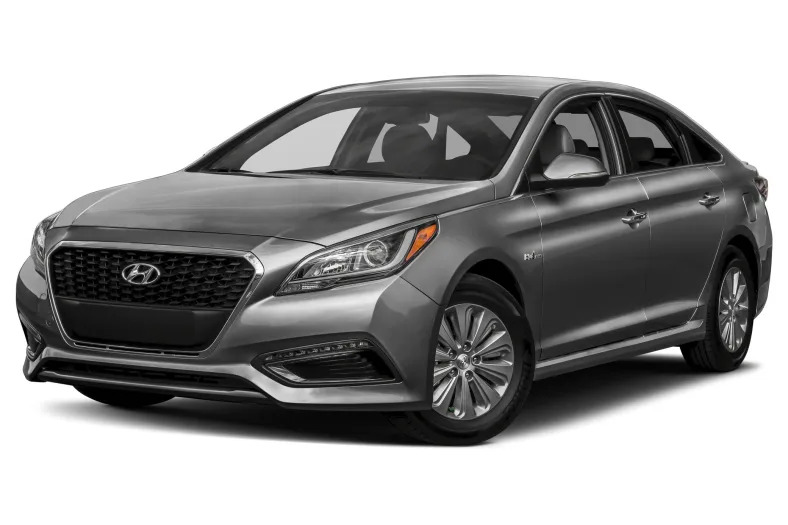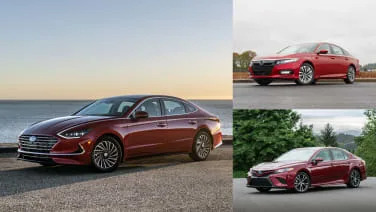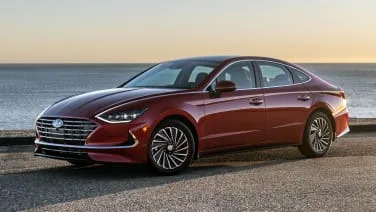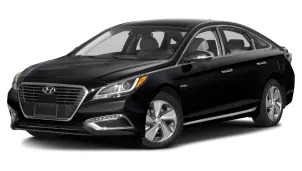2016 Hyundai Sonata Hybrid
Hyundai is coming to the plug-in hybrid sedan party a bit late. No surprise there. Company execs are fully aware of that fact and were eager to say, "Hey, no big deal," at a media briefing on the new 2016 Sonata Hybrid and Plug-In Hybrid in California last week. The press materials for the new cars offered lots of comparison charts that "proved" (using numbers) that the Hyundais are all-around better than their midsize competition. While Hyundai is at the forefront of the hydrogen fuel cell game in the US with the Tucson Fuel Cell Vehicle, the Korean automaker has a lot of ground to make up when it comes to plug-in vehicles. Good thing, then, that the Sonata is a smooth operator and solid performer out on the road. If you're going to show up late, you better make a dramatic entrance. While I much prefer the distinctive shape of the sixth-generation Sonata, there's nothing inherently bad about the new style in the current models. The Hybrid and PHEV update the seventh-gen look of the 2015 Sonata with more aerodynamic front and rear ends, new rocker panels, distinctive headlights and taillights, and eco-spoke alloy wheels. All of these changes reduce drag, dropping the coefficient from 0.27 in the gas-only car to 0.24 for the hybrids. You know what other vehicle has a 0.24 cD? The Tesla Model S. We asked why the standard Sonata doesn't get this slippery update and were told that the improvements came along after the gas model's design had been locked in, but there is a chance some of these changes will find their way to the non-electric vehicle in a future facelift. After spending a day with the new Sonatas, I can say that Hyundai is most welcome at the plug-in vehicle party. The Honda Accord PHEV and Ford Fusion Energi don't get the attention or sales they deserve, and there are some who will say Hyundai got all dressed up for a shindig that's not really worth attending (ever-stricter fuel economy regulations beg to differ). But the more the merrier, in my opinion. And since the Sonata PHEV will indeed be available in all 50 states (with a big caveat) later this year, it won't be long until we see if Hyundai can inject some life into the scene. The main problem is that we don't yet really know how the PHEV compares in terms of MSRP, since Hyundai isn't releasing pricing until some point closer to launch. The automaker did say it expects the PHEV to qualify for a $4,919 tax credit from the federal government. I got to test both the Hybrid and the PHEV (in prototype form) for about 30 miles each on some easy, breezy roads in Southern California, including a blissfully traffic-free I-5. I'll focus on the PHEV here, since it's more exciting, both in the way it drives and as a new product. Visually, it's difficult to tell the two cars apart when you're standing next to …
Full Review
Hyundai is coming to the plug-in hybrid sedan party a bit late. No surprise there. Company execs are fully aware of that fact and were eager to say, "Hey, no big deal," at a media briefing on the new 2016 Sonata Hybrid and Plug-In Hybrid in California last week. The press materials for the new cars offered lots of comparison charts that "proved" (using numbers) that the Hyundais are all-around better than their midsize competition. While Hyundai is at the forefront of the hydrogen fuel cell game in the US with the Tucson Fuel Cell Vehicle, the Korean automaker has a lot of ground to make up when it comes to plug-in vehicles. Good thing, then, that the Sonata is a smooth operator and solid performer out on the road. If you're going to show up late, you better make a dramatic entrance. While I much prefer the distinctive shape of the sixth-generation Sonata, there's nothing inherently bad about the new style in the current models. The Hybrid and PHEV update the seventh-gen look of the 2015 Sonata with more aerodynamic front and rear ends, new rocker panels, distinctive headlights and taillights, and eco-spoke alloy wheels. All of these changes reduce drag, dropping the coefficient from 0.27 in the gas-only car to 0.24 for the hybrids. You know what other vehicle has a 0.24 cD? The Tesla Model S. We asked why the standard Sonata doesn't get this slippery update and were told that the improvements came along after the gas model's design had been locked in, but there is a chance some of these changes will find their way to the non-electric vehicle in a future facelift. After spending a day with the new Sonatas, I can say that Hyundai is most welcome at the plug-in vehicle party. The Honda Accord PHEV and Ford Fusion Energi don't get the attention or sales they deserve, and there are some who will say Hyundai got all dressed up for a shindig that's not really worth attending (ever-stricter fuel economy regulations beg to differ). But the more the merrier, in my opinion. And since the Sonata PHEV will indeed be available in all 50 states (with a big caveat) later this year, it won't be long until we see if Hyundai can inject some life into the scene. The main problem is that we don't yet really know how the PHEV compares in terms of MSRP, since Hyundai isn't releasing pricing until some point closer to launch. The automaker did say it expects the PHEV to qualify for a $4,919 tax credit from the federal government. I got to test both the Hybrid and the PHEV (in prototype form) for about 30 miles each on some easy, breezy roads in Southern California, including a blissfully traffic-free I-5. I'll focus on the PHEV here, since it's more exciting, both in the way it drives and as a new product. Visually, it's difficult to tell the two cars apart when you're standing next to …
Hide Full Review
Hide Full Review
Retail Price
$26,000 - $30,100
MSRP / Window Sticker Price
| Engine | I-4 |
| MPG | Up to 40 city / 44 highway |
| Seating | 5 Passengers |
| Transmission | 6-spd w/OD |
| Power | 154 @ 6000 rpm |
| Drivetrain | front-wheel |
| Curb Weight | 3,497 - 3,560 lbs |
Smart Buy Program is powered by 






